Related Research Articles
In historiography, periodization is the process or study of categorizing the past into discrete, quantified, and named blocks of time for the purpose of study or analysis. This is usually done in order to understand current and historical processes, and the causality that might have linked those events.
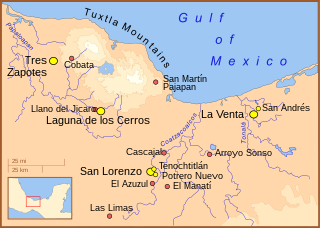
The Olmecs were the earliest known major Mesoamerican civilization. Following a progressive development in Soconusco, they occupied the tropical lowlands of the modern-day Mexican states of Veracruz and Tabasco. It has been speculated that the Olmecs derived in part from the neighboring Mokaya or Mixe–Zoque cultures.

The archaeology of the Americas is the study of the archaeology of the Western Hemisphere, including North America (Mesoamerica), Central America, South America and the Caribbean. This includes the study of pre-historic/Pre-Columbian and historic indigenous American peoples, as well as historical archaeology of more recent eras, including the Trans-Atlantic slave trade and European colonization.

La Venta is a pre-Columbian archaeological site of the Olmec civilization located in the present-day Mexican state of Tabasco. Some of the artifacts have been moved to the museum "Parque - Museo de La Venta", which is in nearby Villahermosa, the capital of Tabasco.
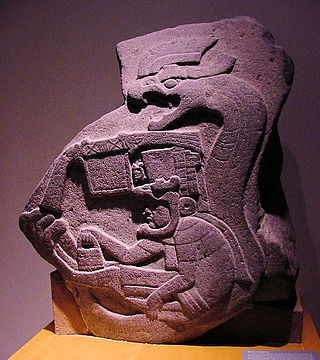
The religion of the Olmec people significantly influenced the social development and mythological world view of Mesoamerica. Scholars have seen echoes of Olmec supernatural in the subsequent religions and mythologies of nearly all later pre-Columbian era cultures.
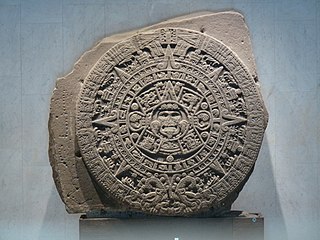
Pre-Columbian art refers to the visual arts of indigenous peoples of the Caribbean, North, Central, and South Americas from at least 13,000 BCE to the European conquests starting in the late 15th and early 16th centuries. The pre-Columbian era continued for a time after these in many places, or had a transitional phase afterwards. Many types of perishable artifacts that were once very common, such as woven textiles, typically have not been preserved, but Precolumbian monumental sculpture, metalwork in gold, pottery, and painting on ceramics, walls, and rocks have survived more frequently.
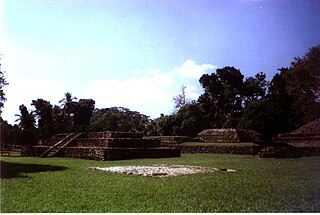
Izapa is a very large pre-Columbian archaeological site located in the Mexican state of Chiapas; it is best known for its occupation during the Late Formative period. The site is situated on the Izapa River, a tributary of the Suchiate River, near the base of the volcano Tacaná, the sixth tallest mountain in Mexico.

Tres Zapotes is a Mesoamerican archaeological site located in the south-central Gulf Lowlands of Mexico in the Papaloapan River plain. Tres Zapotes is sometimes referred to as the third major Olmec capital, but the Olmec phase is only a portion of the site's history, which continued through the Epi-Olmec and Classic Veracruz cultural periods.

The use of jade in Mesoamerica for symbolic and ideological ritual was highly influenced by its rarity and value among pre-Columbian Mesoamerican cultures, such as the Olmec, the Maya, and the various groups in the Valley of Mexico. Although jade artifacts have been created and prized by many Mesoamerican peoples, the Motagua River valley in Guatemala was previously thought to be the sole source of jadeite in the region.

San Lorenzo Tenochtitlán or San Lorenzo is the collective name for three related archaeological sites—San Lorenzo, Tenochtitlán and Potrero Nuevo—located in the southeast portion of the Mexican state of Veracruz. Along with La Venta and Tres Zapotes, it was one of the three major cities of the Olmec, and the major center of Olmec culture from 1400 BCE to 900 BCE. San Lorenzo Tenochtitlán is best known today for the colossal stone heads unearthed there, the greatest of which weigh 28 metric tons or more and are 3 metres (9.8 ft) high.
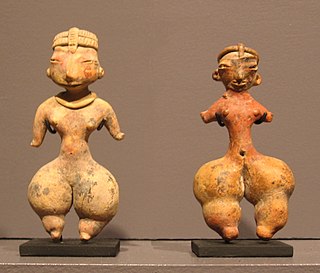
Tlatilco culture is a culture that flourished in the Valley of Mexico between the years 1250 BCE and 800 BCE, during the Mesoamerican Early Formative period. Tlatilco, Tlapacoya, and Coapexco are the major Tlatilco culture sites.
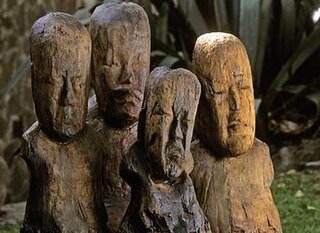
El Manatí is an archaeological site located approximately 60 km south of Coatzacoalcos, in the municipality of Hidalgotitlán 27 kilometers southeast of Minatitlán in the Mexican state of Veracruz. El Manatí was the site of a sacred Olmec sacrificial bog from roughly 1600 BCE until 1200 BCE.

Las Bocas is a minor archaeological site in the Mexican state of Puebla, whose name has become attached, often erroneously, to a wide-ranging type of Olmec-style figurines and pottery.

Las Limas Monument 1, also known as the Las Limas figure or the Señor de las Limas, is a 55 centimetres (22 in) greenstone figure of a youth holding a limp were-jaguar baby. Found in the State of Veracruz, Mexico, in the Olmec heartland, the statue is famous for its incised representations of Olmec supernaturals. It is the largest known greenstone sculpture.

The Lima culture was an indigenous civilization which existed in modern-day Lima, Peru during the Early Intermediate Period, extending from roughly 100 to 650. This pre-Incan culture, which overlaps with surrounding Paracas, Moche, and Nasca civilizations, was located in the desert coastal strip of Peru in the Chillon, Rimac and Lurin River valleys. It can be difficult to differentiate the Lima culture from surrounding cultures due to both its physical proximity to other, and better documented cultures, in Coastal Peru, and because it is chronologically very close, if not over lapped, by these other cultures as well. These factors all help contribute to the obscurity of the Lima culture, of which much information is still left to be learned.

Xochipala is a minor archaeological site in the Mexican state of Guerrero, whose name has become attached, somewhat erroneously, to a style of Formative Period figurines and pottery from 1500 to 200 BCE. The archaeological site is much later and belongs to the Classic and Postclassic eras, approximately 200–1400 CE.
Heather Lechtman is an American materials scientist and archaeologist, and Director at the Center for Materials Research in Archaeology and Ethnology (CMRAE) at the Massachusetts Institute of Technology. She specializes in prehistoric technology of the Andean area of South America, and in particular metallurgy.
La Joya is a Mesoamerican prehispanic archeological site, located in the municipality of Medellín in central Veracruz, Mexico, about 15 kilometers from the port of Veracruz, near the confluence of the Jamapa and Cotaxtla Rivers.

Ancon (archaeological site) is located in the north of the Bay of Ancon, in the Ancón District, on the central coast of Peru. It is one of the most important centers of the Peruvian archeology and features a vast necropolis of the pre-Hispanic era, with countless funerary sites. Permanent occupation in Ancon is documented throughout all periods of Andean history. The oldest evidence of human occupation dates back 10,000 years ago to the preceramic period.
References
- Pool, Christopher A. (2007). Olmec Archaeology and Early Mesoamerica. Cambridge: Cambridge University Press. ISBN 978-0-521-78882-3.
- David W. Anthony (2007). "How to Reconstruct a Dead Culture". The Horse, the Wheel, and Language: How Bronze-Age Riders from the Eurasian Steppes Shaped the Modern World. Princeton University Press. pp. 131–. ISBN 978-0-691-05887-0 . Retrieved 21 October 2011.